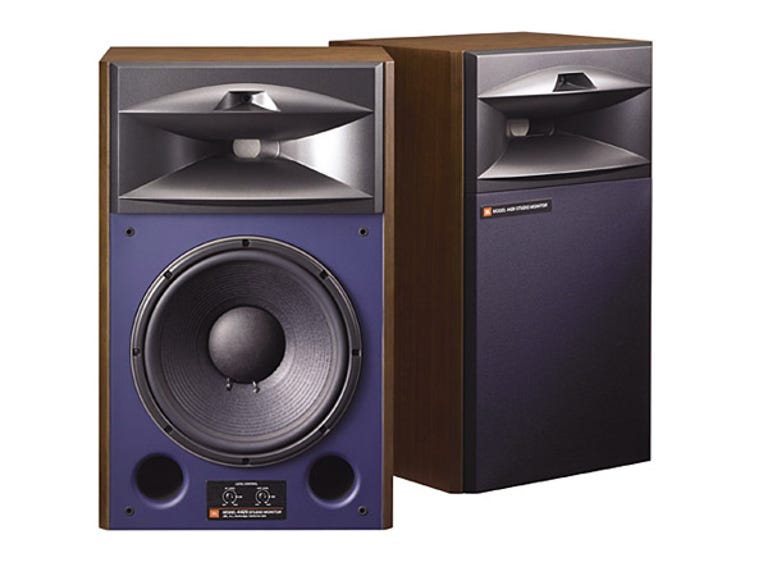 Why You Can Trust CNET
Why You Can Trust CNET JBL Model 4429 stereo loudspeakers review: JBL Model 4429 stereo loudspeakers
If precision is your listening aim, then the JBL Model 4429 Studio Monitor stereo loudspeakers ought to be on your audition list.
System
Talk about eschewing styling norms; the JBL Model 4429 Studio Monitor speakers look a great deal like many of the loudspeakers made in the 1970s. It's the colour of the wood veneer and the grille, in part, but mostly it's the shape. These speakers aren't especially tall, but they are wide across the front and relatively shallow. In recent times, big speakers have been tall, narrow across the face and relatively deep in the body.
The Good
The Bad
The Bottom Line
But it would be difficult to make these speakers narrow. For one thing, the mighty, 300mm bass driver forces a certain minimum width, and even more so does the wide horn on the 50mm mid/treble driver, which extends from side to side of the baffle. Built in to the top part of that horn is another much smaller one that is backed by a 19mm driver that might be called a semi-super-tweeter. Even three-way loudspeaker systems normally have the tweeter kick in around 2500 or 3000 hertz. This one starts working at 7000 hertz, and carries frequencies up to 45,000 hertz (if there are any in your signal, which will very rarely be the case).
One other throwback: the speakers have hidden under their grilles trim pots; little volume controls for the mid/treble driver and for the semi-super tweeter, in case you want to tune the sound in some particular way. I'd warn against touching these, unless you are extremely experienced, and preferably if you have measuring equipment. Fortunately, their zero point is clearly marked.
The speakers are bass reflex loaded with a pair of ports at the front under the grille cloth. They are extremely well constructed, massively braced internally and weigh a ton — well, a bit more than 32 kilograms each, anyway.
Sound
As recommended in the manual, we put these speakers on lowish stands. The point of this is to reduce reflections of sound from close surfaces (aka, the floor) that bounce up and interfere with the directly radiated sound, thereby colouring it.
Starting with classical music, it soon became obvious that the speakers were enormously powerful and capable of producing close to concert-realistic levels. On the orchestral strings, though, they seemed a bit harsh. This wasn't a function of volume. Time and again, we turned up these speakers and we ran out of courage before they seemed anywhere near their limits (remembering we had well over 200 clean watts of power available to each). So it wasn't that.
We thought perhaps that they may have been emphasising the mid-treble a little, bringing forth an inherent stridency in much orchestral recording, so we ran a quick frequency-response measurement, and they delivered a near clinically smooth result.
Then we realised the likely explanation: these speakers have not been tuned to produce a euphonious sound. They have been engineered to produce an accurate sound. They are, after all, called "Studio Monitors". Where many modern speakers have a slight mellow quality that smoothes strings, these delivered them as they were recorded.
On rock music, the ability to deliver great volume levels was welcome, as well. If you have the occasional neighbour-bothering party, these speakers will happily take a break from critical high fidelity listening and slum it with extremely loud dance music delivery.
At the extremes, the drums didn't punch out above the mix quite to the extent that we had expected, suggesting perhaps a slight touch of dynamic compression. The bass was beautifully strong, down to at least the 40 hertz claimed, and we suspect a bit beyond. But the very deepest register was missing, of course. That's only the kind of deep bass that is on unusual tracks, so few will miss it.
Whatever the style of music, these provide truly excellent detail. These high-end speakers leave nothing to the imagination. If a digital sample is offset by a single bit due to some subtle sound captured in the mix, you will hear it with these speakers.
The stereo imaging was sharp, and occasionally evoked an almost eerie sense of depth in the sound. But the top performance required us to be very precisely positioned at the apex of the listening triangle. Drifting a few tens of centimetres from this made the system adopt more of a wall-of-sound style.
Overall
If precision is your listening aim, then the JBL Model 4429 Studio Monitor stereo loudspeakers ought to be on your audition list
.

